
Tornabuoni Chapel
Encyclopedia
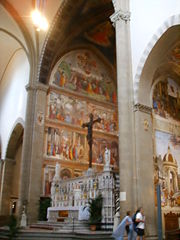
Chancel
In church architecture, the chancel is the space around the altar in the sanctuary at the liturgical east end of a traditional Christian church building...
) in the church of Santa Maria Novella
Basilica di Santa Maria Novella
Santa Maria Novella is a church in Florence, Italy, situated just across from the main railway station which shares its name. Chronologically, it is the first great basilica in Florence, and is the city's principal Dominican church....
, Florence
Florence
Florence is the capital city of the Italian region of Tuscany and of the province of Florence. It is the most populous city in Tuscany, with approximately 370,000 inhabitants, expanding to over 1.5 million in the metropolitan area....
, Italy
Italy
Italy , officially the Italian Republic languages]] under the European Charter for Regional or Minority Languages. In each of these, Italy's official name is as follows:;;;;;;;;), is a unitary parliamentary republic in South-Central Europe. To the north it borders France, Switzerland, Austria and...
. It is famous for the extensive and well-preserved fresco
Fresco
Fresco is any of several related mural painting types, executed on plaster on walls or ceilings. The word fresco comes from the Greek word affresca which derives from the Latin word for "fresh". Frescoes first developed in the ancient world and continued to be popular through the Renaissance...
cycle on its walls, one of the most complete in the city, which was created by Domenico Ghirlandaio
Domenico Ghirlandaio
Domenico Ghirlandaio was an Italian Renaissance painter from Florence. Among his many apprentices was Michelangelo.-Early years:Ghirlandaio's full name is given as Domenico di Tommaso di Currado di Doffo Bigordi...
and his workshop between 1485 and 1490.
History
The main chapel of Santa Maria Novella was first frescoed in the mid-14th century by Andrea OrcagnaAndrea Orcagna
Andrea di Cione di Arcangelo , better known as Orcagna, was an Italian painter, sculptor, and architect active in Florence. A student of Andrea Pisano as well as Giotto di Bondone, his younger brothers Jacopo di Cione and Nardo di Cione were also artists...
. Remains of these paintings were found during restorations in the 1940s: these included, mostly in the vault, figures from the Old Testament
Old Testament
The Old Testament, of which Christians hold different views, is a Christian term for the religious writings of ancient Israel held sacred and inspired by Christians which overlaps with the 24-book canon of the Masoretic Text of Judaism...
. Some of these were detached and can be seen today in the Museum of the church.
By the late 15th century, Orcagna's frescoes were in poor condition. The Sassetti, a rich and powerful Florentine family who were the bankers of the Medici, had long held the right to decorate the main altar
Altar
An altar is any structure upon which offerings such as sacrifices are made for religious purposes. Altars are usually found at shrines, and they can be located in temples, churches and other places of worship...
of the chapel, while the walls and the choir had been assigned to the Ricci family. However, the Ricci had never recovered from their bankruptcy in 1348, and so they arranged to sell their rights to the choir to the Sassetti. Francesco Sassetti wanted the new frescoes to portray stories of St. Francis of Assisi
Francis of Assisi
Saint Francis of Assisi was an Italian Catholic friar and preacher. He founded the men's Franciscan Order, the women’s Order of St. Clare, and the lay Third Order of Saint Francis. St...
; however, the Dominicans
Dominican Order
The Order of Preachers , after the 15th century more commonly known as the Dominican Order or Dominicans, is a Catholic religious order founded by Saint Dominic and approved by Pope Honorius III on 22 December 1216 in France...
, to whom Santa Maria Novella was entrusted, refused. Sassetti therefore moved the commission to the church of Santa Trinita, where Ghirlandaio executed one of his masterworks, the Sassetti Chapel
Sassetti Chapel
The Sassetti Chapel is a chapel in the basilica of Santa Trinita in Florence, Italy. It is especially notable for its frescoes of the Stories of St. Francis, considered Domenico Ghirlandaio's masterwork.-History:...
. The rights to the chapel in Santa Maria Novella that were lost by the Sassetti were then sold by the Ricci to Giovanni Tornabuoni
Giovanni Tornabuoni
thumb|right|[[Donor portrait]] of Giovanni Tornabuoni in the [[Tornabuoni Chapel]], by Domenico Ghirlandaio.Giovanni Tornabuoni was an Italian merchant, banker and patron of the arts from Florence....
.
Ghirlandaio, who then had the largest workshop in Florence, did not lose the commission however, because on September 1, 1485 Giovanni Tornabuoni commissioned him to paint the main chapel, this time with the lives of the Virgin
Mary (mother of Jesus)
Mary , commonly referred to as "Saint Mary", "Mother Mary", the "Virgin Mary", the "Blessed Virgin Mary", or "Mary, Mother of God", was a Jewish woman of Nazareth in Galilee...
and St. John the Baptist
John the Baptist
John the Baptist was an itinerant preacher and a major religious figure mentioned in the Canonical gospels. He is described in the Gospel of Luke as a relative of Jesus, who led a movement of baptism at the Jordan River...
, patron of Tornabuoni and of the city of Florence. It is possible that the new scenes followed the same pattern as Orcagna's.
Ghirlandaio worked to the frescoes from 1485 to 1490, with the collaboration of his workshop artists, who included his brothers Davide
Davide Ghirlandaio
Davide Ghirlandaio , also known as David Ghirlandaio and as Davide Bigordi, was an Italian painter and mosaicist, active in his native Florence....
and Benedetto
Benedetto Ghirlandaio
Benedetto Ghirlandaio was an Italian painter. His brothers Davide Ghirlandaio and Domenico Ghirlandaio were both painters, as was his nephew Ridolfo Ghirlandaio...
, his brother-in-law Sebastiano Mainardi and, probably, the young Michelangelo Buonarroti
Michelangelo
Michelangelo di Lodovico Buonarroti Simoni , commonly known as Michelangelo, was an Italian Renaissance painter, sculptor, architect, poet, and engineer who exerted an unparalleled influence on the development of Western art...
. The windows were also executed according to Ghirlandaio's design. The complex was completed by an altarpiece portraying the Madonna del Latte in Glory with Angel and Saints, flanked by two panels with St. Catherine of Siena and St. Lawrence. On the recto a Resurrection of Christ was painted. This work is now held divided between the Gemäldegalerie, Berlin
Gemäldegalerie, Berlin
The Gemäldegalerie is an art museum in Berlin, Germany. It holds one of the world's leading collections of European art from the 13th to the 18th centuries. It is located on Kulturforum west of Potsdamer Platz. Its collection includes masterpieces from such artists as Albrecht Dürer, Lucas...
and the Alte Pinakothek
Alte Pinakothek
The Alte Pinakothek is an art museum situated in the Kunstareal in Munich, Germany. It is one of the oldest galleries in the world and houses one of the most famous collections of Old Master paintings...
, Munich
Munich
Munich The city's motto is "" . Before 2006, it was "Weltstadt mit Herz" . Its native name, , is derived from the Old High German Munichen, meaning "by the monks' place". The city's name derives from the monks of the Benedictine order who founded the city; hence the monk depicted on the city's coat...
.

Structure of the cycle
The cycle portrays on three walls the Life of the VirginLife of the Virgin
The Life of the Virgin, showing narrative scenes from the life of Mary, the mother of Jesus, is a common subject for pictorial cycles in Christian art, often complementing, or forming part of, a cycle on the Life of Christ. In both cases the number of scenes shown varies greatly with the space...
and the Life of St John the Baptist, the patron saint
Patron saint
A patron saint is a saint who is regarded as the intercessor and advocate in heaven of a nation, place, craft, activity, class, clan, family, or person...
of Florence. The left and right walls each have three rows, each divided into two rectangular scenes framed by fictive architecture, and surmounted by a large lunette
Lunette
In architecture, a lunette is a half-moon shaped space, either filled with recessed masonry or void. A lunette is formed when a horizontal cornice transects a round-headed arch at the level of the imposts, where the arch springs. If a door is set within a round-headed arch, the space within the...
beneath the vault. Each side wall has a total of seven narrative scenes which are read beginning from the bottom.
The chancel wall has a large mullioned window
Mullion
A mullion is a vertical structural element which divides adjacent window units. The primary purpose of the mullion is as a structural support to an arch or lintel above the window opening. Its secondary purpose may be as a rigid support to the glazing of the window...
of three lights with stained glass
Stained glass
The term stained glass can refer to coloured glass as a material or to works produced from it. Throughout its thousand-year history, the term has been applied almost exclusively to the windows of churches and other significant buildings...
, provided in 1492 by Alessandro Agolanti after Ghirlandaio's design. On the lower part of the wall is a donor portrait
Donor portrait
A donor portrait or votive portrait is a portrait in a larger painting or other work showing the person who commissioned and paid for the image, or a member of his, or her, family...
of Giovanni Tornabuoni and his wife Francesca Pitti, while on either side of the window are four smaller scenes portraying Dominican saints. Above the window is another large lunette, containing the Coronation of the Virgin
Coronation of the Virgin
The Coronation of the Virgin or Coronation of Mary is a subject in Christian art, especially popular in Italy in the 13th to 15th centuries, but continuing in popularity until the 18th century and beyond. Christ, sometimes accompanied by God the Father and the Holy Spirit in the form of a dove,...
. In the vault are depicted the Four Evangelists
Four Evangelists
In Christian tradition the Four Evangelists are Matthew, Mark, Luke, and John, the authors attributed with the creation of the four Gospel accounts in the New Testament that bear the following titles:*Gospel according to Matthew*Gospel according to Mark...
.
The life of the Blessed Virgin The scenes are on the left side of the chapel:
|
The life of St John the Baptist The scenes on the right side of the chapel are:
|
Dominican saints and the donors The scenes of the upper and lower tiers of the central wall are:
|
The four Evangelists Depicted on the vault are:
|
Scenes from the life of the Blessed Virgin Mary
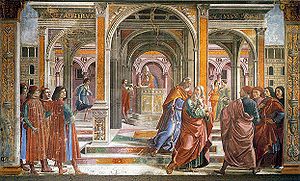
Expulsion of Joachim
The first episode represents the expulsion of JoachimJoachim
Saint Joachim was the husband of Saint Anne and the father of Mary, the mother of Jesus in the Roman Catholic, Orthodox, and Anglican traditions. The story of Joachim and Anne appears first in the apocryphal Gospel of James...
, the father of Mary
Mary (mother of Jesus)
Mary , commonly referred to as "Saint Mary", "Mother Mary", the "Virgin Mary", the "Blessed Virgin Mary", or "Mary, Mother of God", was a Jewish woman of Nazareth in Galilee...
, from the Temple of Jerusalem. A ceremony is taking place in which several figures are carrying lambs for sacrifice. However, Joachim was banned from attending due to his alleged sterility.
Ghirlandaio set the scene in a sumptuous loggia
Loggia
Loggia is the name given to an architectural feature, originally of Minoan design. They are often a gallery or corridor at ground level, sometimes higher, on the facade of a building and open to the air on one side, where it is supported by columns or pierced openings in the wall...
of Greek cross plan, with a sequence of arches in the background and an octagonal altar in the middle, where the sacrificial fire is lit. The characters are illuminated from above, as if by the natural lighting from the real chapel windows.
Two groups of Florentine people, representing the populace, are shown to the sides of the scene. They wear contemporary fashionable clothes (for which the frescoes are a famous source), unlike the main biblical figures, who wear the usual "iconographic costume". On the left, two figures may be identified as Lorenzo Tornabuoni, son of Ghirlandaio's patron, and Piero di Lorenzo de' Medici
Piero di Lorenzo de' Medici
Piero de' Medici , called Piero the Unfortunate, was the Gran maestro of Florence from 1492 until his exile in 1494.-Life and death:...
, the former's friend. In the righthand group is a self-portrait
Self-portrait
A self-portrait is a representation of an artist, drawn, painted, photographed, or sculpted by the artist. Although self-portraits have been made by artists since the earliest times, it is not until the Early Renaissance in the mid 15th century that artists can be frequently identified depicting...
of the artist with some of his relatives. The loggia in the background could be a representation of the Ospedale di San Paolo (St. Paul's Hospital), which was then under construction in the same square as Santa Maria Novella. The two buildings on the sides are examples of typical edifices of 15th-century Florence, characterized by rustication
Rustication (architecture)
thumb|upright|Two different styles of rustication in the [[Palazzo Medici-Riccardi]] in [[Florence]].In classical architecture rustication is an architectural feature that contrasts in texture with the smoothly finished, squared block masonry surfaces called ashlar...
and an upper loggia.
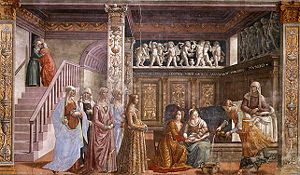
Nativity of Mary
The second scene portrays the Nativity of Mary, set in a luxurious room with inlaid wooden panelling surmounted by a frieze in bas-relief of music-making puttiPutto
A putto is a figure of an infant often depicted as a young male. Putti are defined as chubby, winged or wingless, male child figure in nude. Putti are distinct from cherubim, but some English-speakers confuse them with each other, except that in the plural, "the Cherubim" refers to the biblical...
and a cornice
Cornice
Cornice molding is generally any horizontal decorative molding that crowns any building or furniture element: the cornice over a door or window, for instance, or the cornice around the edge of a pedestal. A simple cornice may be formed just with a crown molding.The function of the projecting...
of winged cherubs. The room is divided by piers decorated in relief. To the left, near the door at the top of the stairs is shown symbolically an early incident of the story, the embrace of Anne
Saint Anne
Saint Hanna of David's house and line, was the mother of the Virgin Mary and grandmother of Jesus Christ according to Christian and Islamic tradition. English Anne is derived from Greek rendering of her Hebrew name Hannah...
and Joachim at the Golden Gate of Jerusalem.
To the right, St. Anne reclines in bed, while three young women prepare to bath the new-born Mary. The nurse who is pouring water into a basin is the only figure in the room to be moving rapidly. Her flowing robes and swirling scarf make her an iconic motif to be found in many painings both by Ghirlandaio and other painters and sculptors of the period. A preparatory drawing of this woman has been preserved in the Cabinet of Prints and Drawings of the Uffizi
Uffizi
The Uffizi Gallery , is a museum in Florence, Italy. It is one of the oldest and most famous art museums of the Western world.-History:...
.
Several well-dressed Florentine ladies have come on a congratulatory visit. The first in the procession of noblewoman, portrayed in profile, is Ludovica, daughter of Giovanni Tornabuoni. The rendering of the magnificent women's clothes is particularly notable. The scene is considered one of the best executed in the chapel. Unlike the previous scene, nearly all the portraits show a great care: they were probably executed by the master himself, while the less well executed are probably painted by his assistants.
Above the cabinets in the background is an inscription reading: "NATIVITAS TUA DEI GENITRIX VIRGO GAUDIUM ANNUNTIAVIT UNIVERSO MUNDO" ("Your birth, oh Virgin Mother, announced joy to the whole universe"), while in the intarsia
Intarsia
Intarsia is a form of wood inlaying that is similar to marquetry. The term is also used for a similar technique used with small, highly polished stones set in a marble matrix .- History :...
decoration the artist put his signature: "BIGHORDI" (his true surname, Bigordi) and "GRILLANDAI" (the Florentine version of his nickname).
This scene, like the previous one, is realistically illuminated, with the frieze on the right in shadow. While the majority of scenes in the chapel have a completely symmetrical arrangement in their internal architecture and even the positioning of the figures, this picture is markedly asymmmetrical, with a pier dividing it into two areas based on the golden mean
Golden mean
Golden mean may refer to:*Doctrine of the Golden Mean , a chapter in Li Ji, one of the Four Books of Confucianism*Golden mean , the felicitous middle between the extremes of excess and deficiency...
. This asymmmetrical structure links it to the scene of The Visitation in which a wall is placed to divide the picture space in the same manner. However the positioning of the figures, with St. Anne in bed and the group entering from the left is mirrored by The Birth of St John, although there the figures are placed in a much more conventional internal space.

Presentation at the Temple
The Presentation is a complex composition, with numerous characters placed on different levels. In the centre, the young Mary, holding a book, is ascending the Temple's staircase towards the priest, but is looking in the viewer's direction. Her awkward posture is perhaps intended to suggest her young shyness, but the figure appears rather awkward.The role and meaning of the other figures who crowd the classical architectures of the scene are still partly unclear. The female figures on the right, portrayed with notable attention to detail, are probably portraits of real contemporary women. Next to them are St. Anne and Joachim, distinguishable by aureola
Aureola
An aureola or aureole is the radiance of luminous cloud which, in paintings of sacred personages, surrounds the whole figure...
s, who point at their daughter Mary. Two young women, painted by workshop collaborators, are rushing out from the Temple.
The two small figures in the centre foreground have not been identified. They could be children, but have adult features. It has been suggested that, being observed from below, they acquire a more youthful appearance, so their unusual rendering could be a technical trick by Ghirlandaio. The symbolic role of the nude man sitting on the steps, on the right, is unknown. Next to him are two old men.
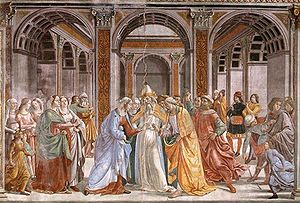
Marriage of the Virgin
The Marriage of the Virgin is set in beautiful Renaissance architecture, while the composition of the scene is rather traditional. In the centre is the temple priest, with the same features as in the Presentation. He is sealing the marriage between JosephSaint Joseph
Saint Joseph is a figure in the Gospels, the husband of the Virgin Mary and the earthly father of Jesus Christ ....
and Mary. To the sides are two processions, with men on the left and women on the right. Some of the former, angry at having not been chosen to marry Mary, are shown while breaking their sticks or raising their fists (a story originating in apocryphal legends of the life of Mary). Joseph's club, which had been chosen as the most vigorous, is barely visible over his shoulder. Most of the portraits are summary in style, apart some very carefully executed ones near the priest.
It is not clear if the shorter figures in both lower corner are children or have a different symbolic meaning.
A preparatory sketch for this scene has been preserved in the Gabinetto dei Disegni e Stampe
Print room
A print room is either a room or industrial building where printing takes place, or a room in an art gallery or museum, where a collection of old master and modern prints, usually together with drawings, watercolours and photographs, are held and viewed. The latter meaning is the subject of this...
in the Uffizi
Uffizi
The Uffizi Gallery , is a museum in Florence, Italy. It is one of the oldest and most famous art museums of the Western world.-History:...
, in which the priest in the centre is absent.
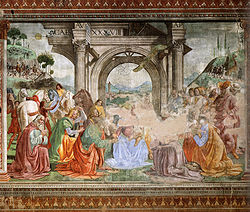
Adoration of the Magi
In several details this scene resembles the version in the Sassetti Chapel (also produced by Ghirlandaio), for example in the ruins and the hills which the Magis' procession is crossing. It is the most damaged section of the cycle, having lost much of the intonacoIntonaco
Intonaco is an Italian term for the final, very thin layer of plaster on which a fresco is painted. The plaster is painted while still wet, in order to allow the pigment to penetrate into the intonaco itself...
in the central area.
Mary and the Child Jesus are in the centre, framed by an arch with the inscription: CAES[AR] AUGUSTO XXXVIII AP. The Magi are finely executed: the younger one on the left in particular, who is already taking off his crown as a sign of deference.
The peacock on the arch is a symbol of the Resurrection. The men on the right, whose clothes suggest that they could be foreign ambassadors, are most likely portraits of Ghirlandaio's contemporaries. In the procession on the righthand hill a giraffe
Giraffe
The giraffe is an African even-toed ungulate mammal, the tallest of all extant land-living animal species, and the largest ruminant...
rendered with noteworthy realism can be seen (a giraffe
Medici giraffe
The Medici giraffe was a giraffe presented to Lorenzo de Medici in 1486 possibly by al-Ashraf Qaitbay, the Burji Mamluke sultan of Egypt, in an attempt to win the support of the Medici....
had been presented to Lorenzo de' Medici
Lorenzo de' Medici
Lorenzo de' Medici was an Italian statesman and de facto ruler of the Florentine Republic during the Italian Renaissance. Known as Lorenzo the Magnificent by contemporary Florentines, he was a diplomat, politician and patron of scholars, artists and poets...
and brought to Florence in 1486).
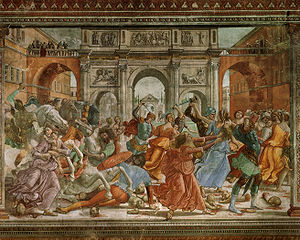
Massacre of the Innocents
This scene was the one that Vasari, in his biography of Ghirlandaio, considered the best in the cycle, due to its dramatic and frantic composition. It is probable that Ghirlandaio was inspired by scenes of ancient Roman bas-reliefs, like that depicted on the arch in the background.In the foreground are two mothers fighting to save their babies. The left one is escaping a horseman who is attacking her child with a dagger. The other, on the right, is grasping at the hair of a soldier who holds her child. Notable are the vivid colors and the moving rendering of the clothes.
On the ground are the corpses of numerous children, bleeding and with parts of their bodies severed. Behind on the right, the soldiers are attacking the mothers; one of the soldiers is dramatically falling from his horse. In the background, several people are viewing the scene from terraces connecting the two buildings on the sides with the central triumphal arch
Triumphal arch
A triumphal arch is a monumental structure in the shape of an archway with one or more arched passageways, often designed to span a road. In its simplest form a triumphal arch consists of two massive piers connected by an arch, crowned with a flat entablature or attic on which a statue might be...
.
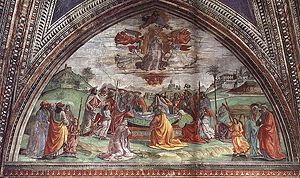
Death and Assumption of the Virgin
The left wall cycle culminates in the large lunette with the scene of Death and Assumption of the Virgin. The painting quality of this picture looks inferior to the rest, showing that Ghirlandaio left most of its execution to his workshop.The body of the aged Virgin is lying on a lawn, surrounded by the Twelve Apostles who kiss her feet in a sign of deference, cry and pray. Angels are holding torches, while one of the Apostles holds a palm, a symbol of Resurrection.
In the upper part of the painting the Virgin is shown again, young and attractive, within an mandorla supported by angels. God is welcoming her. In the background are hills with castles, fortified towns and (on the right) a villa, which is the Villa Medici in Fiesole
Villa Medici in Fiesole
The Villa Medici is a patrician villa in Fiesole, Tuscany, Italy, the fourth oldest of the villas built by the Medici family. It was built between 1451 and 1457.-External links:*...
.
The story of Mary ends in the central wall's lunette with the Coronation of the Virgin.
The cycle joins that of John the Baptist in the scene of the Visitation.
Scenes from the life of St. John the Baptist

Apparition of the Angel to Zechariah
Like the others in the lower wall, this scene is one of the best in the cycle. The Biblical episode of the apparition of the Angel to ZechariahZechariah (priest)
In the Bible, Zechariah , is the father of John the Baptist, a priest of the sons of Aaron, a prophet in , and the husband of Elisabeth who is the cousin of Mary the mother of Jesus.In the Qur'an, Zechariah plays a similar role as the father of John the Baptist and ranks him as a prophet alongside...
is portrayed within magnificent Renaissance church architecture. Zechariah is portrayed on the altar in the centre, with the Angel Gabriel
Gabriel
In Abrahamic religions, Gabriel is an Archangel who typically serves as a messenger to humans from God.He first appears in the Book of Daniel, delivering explanations of Daniel's visions. In the Gospel of Luke Gabriel foretells the births of both John the Baptist and of Jesus...
suddenly appearing on his left to announce to him that he will have a son.
The scene is crowded with six groups of characters on six different levels. Aside from the group of six maidens on the right, the others are all portraits of contemporary Florentine notables. On the lower left are the Renaissance humanist
Renaissance humanism
Renaissance humanism was an activity of cultural and educational reform engaged by scholars, writers, and civic leaders who are today known as Renaissance humanists. It developed during the fourteenth and the beginning of the fifteenth centuries, and was a response to the challenge of Mediæval...
s, including Cristoforo Landino
Cristoforo Landino
Cristoforo Landino was an Italian humanist and an important figure of the Florentine Renaissance.-Biography:...
(the one with a black collar) and Agnolo Poliziano (the second from right). The figures standing on the right are relatives of the patron; behind them is a self-portrait of Ghirlandaio (the second from right, next to a youngster with long hair, probably his son or brother, who is also present in the Expulsion of Joachim).
The inscription on the arch at the left celebrates the completion of the cycle (in 1490), and has a quote by Agnolo Poliziano. The Classical-style altar resembles that painted by Leonardo da Vinci
Leonardo da Vinci
Leonardo di ser Piero da Vinci was an Italian Renaissance polymath: painter, sculptor, architect, musician, scientist, mathematician, engineer, inventor, anatomist, geologist, cartographer, botanist and writer whose genius, perhaps more than that of any other figure, epitomized the Renaissance...
in his Annunciation
Annunciation (Leonardo)
The Annunciation is a a painting by Italian Renaissance artists Leonardo da Vinci and Andrea del Verrocchio, dating from circa 1472–1475 and housed in the Uffizi Gallery of Florence, Italy....
.
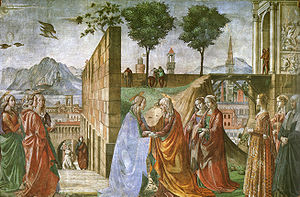
Visitation
This scene portrays the meeting of Mary with the aged ElizabethElizabeth (Biblical person)
Elizabeth is also spelled Elisabeth or Elisheva...
. The complex composition includes in the centre the key episode, the relevance of which is strengthened by the converging lines of the a wall in perspective and a ravine in the background. Behind Elizabeth are two maidens, while on the two extremities are other groups of women. The group on the right include portraits of contemporaries: the first, in profile, is Giovanna degli Albizzi, who had married Giovanni Tornabuoni's son. Vasari wrongly identified her as Ginevra de' Benci
Ginevra de' Benci
Ginevra de' Benci was an aristocrat from 15th-century Florence, admired for her intelligence by Florentine contemporaries. She is the subject of a portrait painting by Leonardo da Vinci...
.
The fine background shows the influence of both classical and Flemish art on Ghirlandaio. On the right is an ancient edifice, while the city landscape on the right is typical of Early Netherlandish painting
Early Netherlandish painting
Early Netherlandish painting refers to the work of artists active in the Low Countries during the 15th- and early 16th-century Northern renaissance, especially in the flourishing Burgundian cities of Bruges and Ghent...
. The balcony in the middle with two young men stretching out is probably a reference to Jan van Eyck
Jan van Eyck
Jan van Eyck was a Flemish painter active in Bruges and considered one of the best Northern European painters of the 15th century....
's Madonna of Chancellor Rolin
Madonna of Chancellor Rolin
The Madonna of Chancellor Rolin is an oil painting by the Early Netherlandish master Jan van Eyck, dating from around 1435. It is on display in the Musée du Louvre, Paris....
, or to Rogier van der Weyden's St. Luke Painting the Madonna. Two other figures are portrayed walking upwards next to the dividing wall. The city is fanciful, but details like the tower of Florence's Palazzo Vecchio
Palazzo Vecchio
The Palazzo Vecchio is the town hall of Florence, Italy. This massive, Romanesque, crenellated fortress-palace is among the most impressive town halls of Tuscany...
and the Santa Maria Novella campanile, as well as Rome's Colosseum
Colosseum
The Colosseum, or the Coliseum, originally the Flavian Amphitheatre , is an elliptical amphitheatre in the centre of the city of Rome, Italy, the largest ever built in the Roman Empire...
are from real buildings.
All the elements in this picture were explicitly required in Tornabuoni's contract with Ghirlandaio: the landscape, the city, the animals, the perspective, the portraits and the classical elements.
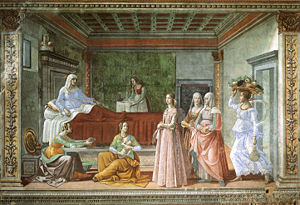
Birth of the Baptist
This scene is linked with that in the opposite wall, the Birth of the Virgin, with which it shares an element of composition having the bed placed symmetrically. This room is less luxurious than the other, but still probably portrays that of a rich Florentine merchant of the time.The light falls heavily on the figures in the foreground, while the others are partially in shade. Elizabeth
Elizabeth (Biblical person)
Elizabeth is also spelled Elisabeth or Elisheva...
is depicted on the bed in a calm and majestic posture, with a book in her left hand. As in the other scene, there are two nurses painted with brilliant colours to attract the watcher's attention. Three women, also in the foreground, are visiting Elizabeth. The first, luxuriously dressed, could be a relative of the Tornabuoni. Of the two other figures, the older is most likely Lucrezia Tornabuoni
Lucrezia Tornabuoni
Lucrezia Tornabuoni was a daughter of Francesco di Simone Tornabuoni and Nanna di Niccolo di Luigi Guicciardini. Her brother was Giovanni Tornabuoni.- Biography :...
, Giovanni's sister, who had recently died. The maid entering from the right with a basket of fruit on her head resembles both one of the nymphs of Botticelli's Primavera and the Salome
Salome
Salome , the Daughter of Herodias , is known from the New Testament...
painted by Filippino Lippi
Filippino Lippi
Filippino Lippi was an Italian painter working during the High Renaissance in Florence, Italy.-Biography:...
in the Prato Cathedral
Prato Cathedral
The Cathedral of Prato is the main Catholic church of Prato, Tuscany, Central Italy and seat of the bishop. It is dedicated to St. Stephen, the first Christian martyr. It is one of the most ancient churches in the city, existing already in the 10th century and having been built and in several...
. In a preparatory drawing now in the Gemäldegalerie, Berlin
Gemäldegalerie, Berlin
The Gemäldegalerie is an art museum in Berlin, Germany. It holds one of the world's leading collections of European art from the 13th to the 18th centuries. It is located on Kulturforum west of Potsdamer Platz. Its collection includes masterpieces from such artists as Albrecht Dürer, Lucas...
the maid is in fact Salome carrying the Baptist's head.
Notable is the attention to domestic detail, which shows again the influence on Ghirlandaio of the Netherlandish school, which was being felt in Tuscany during this period: the two bottles of wine and water held by the maid, the bed-frame with a vase and the two pomegranate
Pomegranate
The pomegranate , Punica granatum, is a fruit-bearing deciduous shrub or small tree growing between five and eight meters tall.Native to the area of modern day Iran, the pomegranate has been cultivated in the Caucasus since ancient times. From there it spread to Asian areas such as the Caucasus as...
s over the bed.
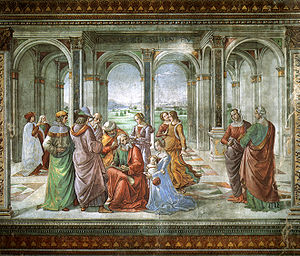
Zechariah Writes John's Name
This scene depicts the moment in which Zechariah, now mute, writes his new son's name on a sheet of paper. It is set under a large portico, which opens on a magnificent landscape created according to aerial perspectiveAerial perspective
Aerial perspective or atmospheric perspective refers to the effect the atmosphere has on the appearance of an object as it is viewed from a distance. As the distance between an object and a viewer increases, the contrast between the object and its background decreases, and the contrast of any...
.
The main scene is in the middle, with Zechariah sitting and looking at his son, who is held in Elizabeth's arm. The figures on the left are symmetrically balanced by a group of two women on the right: this composition allowed the child to appear exactly in the middle of the scene, aligned with the central pilaster of the portico. Behind Zechariah are two old men, while a younger figure, in contemporary clothes, is portrayed from the back.
The Gabinetto delle Stampe e dei Disegni of the Uzzi houses a preparatory sketch for the women on the left.
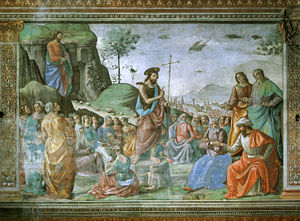
John preaches in the wilderness
In this scene John the Baptist is portrayed in the centre, on a rock, while instructing a crowd who form a circle around him. He wears the camelskins mentioned in the Gospels and is pointing at the cross. A listening Jesus can be seen on the path in the upper left corner.As often with Ghirlandaio there is a group of women on the left. Of particular interest are the woman sitting in the centre, and the child at John's feet.
The execution of the other figures is rather hasty, and is most likely by the artist's workshop, as are many other details in the scenes of the upper chapel walls.
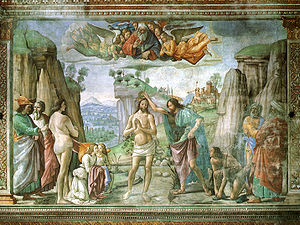
Baptism of Christ
The scene of the baptism follows a traditional scheme: for example, the naked man resembles that of MasaccioMasaccio
Masaccio , born Tommaso di Ser Giovanni di Simone, was the first great painter of the Quattrocento period of the Italian Renaissance. According to Vasari, Masaccio was the best painter of his generation because of his skill at recreating lifelike figures and movements as well as a convincing sense...
's Brancacci Chapel
Brancacci Chapel
The Brancacci Chapel is a chapel in the Church of Santa Maria del Carmine in Florence, central Italy. It is sometimes called the "Sistine Chapel of the early Renaissance" for its painting cycle, among the most famous and influential of the period. Construction of the chapel was commissioned by...
, while the Christ is similar to the panel by Verrocchio and Leonardo at the Uffizi.
Notable is the figure of the kneeling man on the right, who is removing his shoes while looking with curiosity at the scene, while traditional portrayal is again seen with God giving his blessing between the angels, in the upper area, which is in a quasi-Late Gothic style.
The graceful landscape in the background is divided by a spur which creates a frame around Christ's figure. The two pairs of figures at the sides, again hastily painted, were executed by Ghirlandaio's workshop following his design.
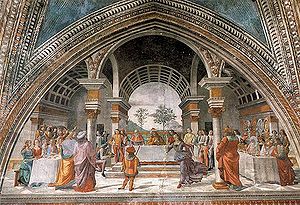
Herod's Banquet
The scene of HerodHerod Antipas
Herod Antipater , known by the nickname Antipas, was a 1st-century AD ruler of Galilee and Perea, who bore the title of tetrarch...
's banquet concludes the story of St. John the Baptist. It is set within a majestic, classical-style hall with a painted arch. The barrel vault
Barrel vault
A barrel vault, also known as a tunnel vault or a wagon vault, is an architectural element formed by the extrusion of a single curve along a given distance. The curves are typically circular in shape, lending a semi-cylindrical appearance to the total design...
resembles that of the Basilica of Maxentius
Basilica of Maxentius
The Basilica of Maxentius and Constantine is an ancient building in the Roman Forum, Rome, Italy...
in Rome
Rome
Rome is the capital of Italy and the country's largest and most populated city and comune, with over 2.7 million residents in . The city is located in the central-western portion of the Italian Peninsula, on the Tiber River within the Lazio region of Italy.Rome's history spans two and a half...
. Two tables along the sides underline the perspective-based composition: the women sit at the left one, while the men are seated at the right. Behind the women is a group of musicians.
At the table in the centre is Herod, with an open window behind him. In the foreground Salome
Salome
Salome , the Daughter of Herodias , is known from the New Testament...
is portrayed performing her dance. Other men (including a dwarf) are looking on the left, where a servant is handing over John's head to Herod. A man nearby is making a gesture of disgust at the sight. The scene is inspired by the work of Filippo Lippi in Prato Cathedral
Prato Cathedral
The Cathedral of Prato is the main Catholic church of Prato, Tuscany, Central Italy and seat of the bishop. It is dedicated to St. Stephen, the first Christian martyr. It is one of the most ancient churches in the city, existing already in the 10th century and having been built and in several...
, but is of lesser dramatic quality; the artwork was most likely provided by Ghirlandaio's workshop almost entirely.

Central wall
On the middle wall are portrayed the following scenes:- Coronation of the Virgin and Saints' (lunette)
- St. Dominic Tests Books in the Fire (#1 in violet - see figure)
- Killing of St. Peter Martyr (#2 in violet - see figure)
- Annunciation (#5 in green - see figure)
- St. John in the Desert (#5 in red - see figure). This painting depicts John wandering in the desert during his youth.
- The Patrons in Prayer (#3 and #4 in violet). These are the portraits of the two patrons, Giovanni Tornabuoni and his wife Francesca Pitti.
Vault
In the groin-vault are four Evangelist portraitEvangelist portrait
Evangelist portraits are a specific type of miniature included in ancient and mediæval illuminated manuscript Gospel Books, and later in Bibles and other books, as well as other media. Each Gospel of the Four Evangelists, the books of Matthew, Mark, Luke, and John, may be prefaced by a portrait of...
s; they write or show their work (apart St. Mark, who is cutting his pen with a knife), flanked by their symbols.
In reference to the figure, they are:
- St. John the Evangelist (1 yellow)
- St. Matthew (2 yellow)
- St. Luke (3 yellow)
- St. Mark (4 yellow)
As in the Sassetti Chapel, and despite being distant from the viewer, the paintings are very well executed, being largely by Ghirlandaio himself. This can be seen, for example, in the realistic rendering of Luke's ox.
Choir and other furniture
The magnificent wooden choir was carved by Baccio d'AgnoloBaccio D'Agnolo
Baccio D'Agnolo , born Bartolomeo Baglioni, was an Italian woodcarver, sculptor and architect from Florence."Baccio"'is an abbreviation of Bartolomeo, and "d'Agnolo" refers to Angelo, his father's name...
during the same period as the execution of the frescoes (1485-1490). Two of the scenes, St. John in the Desert and St. Lawrence, are attributed to Filippino Lippi
Filippino Lippi
Filippino Lippi was an Italian painter working during the High Renaissance in Florence, Italy.-Biography:...
, who at the time was working at the Filippo Strozzi Chapel in the same church. The choir was restored by Vasari in 1566.
The altar is a neo-Gothic creation from the 19th century. The crucifix is by Giambologna
Giambologna
Giambologna, born as Jean Boulogne, incorrectly known as Giovanni da Bologna and Giovanni Bologna , was a sculptor, known for his marble and bronze statuary in a late Renaissance or Mannerist style.- Biography :...
, while the right paschal candle
Paschal candle
The Paschal candle is a large, white candle used at liturgy in the Western Rites of Christianity . A new Paschal candle is blessed and lit every year at Easter, and is used throughout the Paschal season which is during Easter and then throughout the year on special occasions, such as baptisms and...
is attributed to Piero di Giovanni Tedesco (late 14th century); the similar left one is a modern reproduction.

